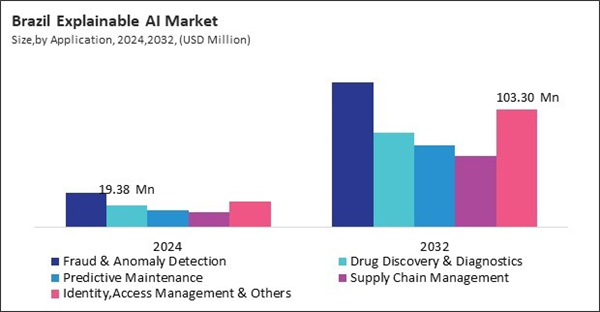The Latin America, Middle East and Africa Explainable AI Market is expected to witness market growth of 22.3% CAGR during the forecast period (2025-2032).
The Brazil market dominated the LAMEA Explainable AI Market by country in 2024, and is expected to continue to be a dominant market till 2032; thereby, achieving a market value of $449 million by 2032. The Argentina market is expected to showcase a CAGR of 23.2% during 2025-2032. Additionally, the UAE market would register a CAGR of 21.2% during 2025-2032.
Global technology vendors and start-ups alike are racing to integrate XAI functionalities into their AI offerings. Major cloud service providers, such as Microsoft Azure, Google Cloud, and AWS, now offer explainability tools and dashboards as part of their AI suites. These tools empower data scientists and business users to interpret, debug, and validate model decisions more effectively. Meanwhile, regulatory frameworks - including the aforementioned GDPR, the US Equal Credit Opportunity Act, and the Algorithmic Accountability Act - are compelling organizations to invest in explainable systems as part of compliance strategies.
However, adoption is not without challenges. XAI often introduces trade-offs between model performance and interpretability, requiring organizations to balance accuracy with transparency. Additionally, the maturity of XAI solutions varies across industries and use cases; while some areas benefit from robust, out-of-the-box explainability frameworks, others - particularly those involving unstructured data or highly complex models - may find current XAI techniques lacking. Despite these hurdles, a growing body of research, improved toolkits, and evolving best practices are helping to accelerate XAI adoption across the enterprise landscape.
Brazil is emerging as a regional leader in the development and adoption of explainable AI (XAI), supported by forward-looking government policies, a vibrant technology sector, and a growing demand for responsible AI across industries. The country’s National Artificial Intelligence Strategy (“Estratégia Brasileira de Inteligência Artificial”) emphasizes the principles of transparency, fairness, and accountability, with explainable AI positioned as a foundational element for trustworthy digital transformation. Brazil’s regulatory focus is strengthened by the Lei Geral de Proteção de Dados (LGPD), the country’s comprehensive data protection law, which mandates transparency in the automated processing of personal data. As a result, organizations developing and deploying AI models must ensure these are not only accurate but also interpretable and auditable.
The Brazil market dominated the LAMEA Explainable AI Market by country in 2024, and is expected to continue to be a dominant market till 2032; thereby, achieving a market value of $449 million by 2032. The Argentina market is expected to showcase a CAGR of 23.2% during 2025-2032. Additionally, the UAE market would register a CAGR of 21.2% during 2025-2032.
Global technology vendors and start-ups alike are racing to integrate XAI functionalities into their AI offerings. Major cloud service providers, such as Microsoft Azure, Google Cloud, and AWS, now offer explainability tools and dashboards as part of their AI suites. These tools empower data scientists and business users to interpret, debug, and validate model decisions more effectively. Meanwhile, regulatory frameworks - including the aforementioned GDPR, the US Equal Credit Opportunity Act, and the Algorithmic Accountability Act - are compelling organizations to invest in explainable systems as part of compliance strategies.
However, adoption is not without challenges. XAI often introduces trade-offs between model performance and interpretability, requiring organizations to balance accuracy with transparency. Additionally, the maturity of XAI solutions varies across industries and use cases; while some areas benefit from robust, out-of-the-box explainability frameworks, others - particularly those involving unstructured data or highly complex models - may find current XAI techniques lacking. Despite these hurdles, a growing body of research, improved toolkits, and evolving best practices are helping to accelerate XAI adoption across the enterprise landscape.
Brazil is emerging as a regional leader in the development and adoption of explainable AI (XAI), supported by forward-looking government policies, a vibrant technology sector, and a growing demand for responsible AI across industries. The country’s National Artificial Intelligence Strategy (“Estratégia Brasileira de Inteligência Artificial”) emphasizes the principles of transparency, fairness, and accountability, with explainable AI positioned as a foundational element for trustworthy digital transformation. Brazil’s regulatory focus is strengthened by the Lei Geral de Proteção de Dados (LGPD), the country’s comprehensive data protection law, which mandates transparency in the automated processing of personal data. As a result, organizations developing and deploying AI models must ensure these are not only accurate but also interpretable and auditable.
List of Key Companies Profiled
- Microsoft Corporation
- IBM Corporation
- Google LLC (Alphabet Inc.)
- Salesforce, Inc.
- Intel Corporation
- NVIDIA Corporation
- SAS Institute Inc.
- Databricks, Inc.
- Amazon Web Services, Inc.
- SAP SE
Market Report Segmentation
By Deployment
- Cloud
- On-premise
By Component
- Solution
- Services
By Application
- Fraud & Anomaly Detection
- Drug Discovery & Diagnostics
- Predictive Maintenance
- Supply Chain Management
- Identity, Access Management & Others
By End-Use
- IT & Telecommunication
- Healthcare
- BFSI
- Aerospace & Defense
- Retail & E-commerce
- Public Sector & Utilities
- Automotive
- Other End-use
By Country
- Brazil
- Argentina
- UAE
- Saudi Arabia
- South Africa
- Nigeria
- Rest of LAMEA
Table of Contents
Chapter 1. Market Scope & Methodology
Chapter 2. Market at a Glance
Chapter 3. Market Overview
Chapter 4. Competition Analysis - Global
Chapter 5. Value Chain Analysis of Explainable AI Market
Chapter 7. LAMEA Explainable AI Market by Deployment
Chapter 8. LAMEA Explainable AI Market by Component
Chapter 9. LAMEA Explainable AI Market by Application
Chapter 10. LAMEA Explainable AI Market by End-use
Chapter 11. LAMEA Explainable AI Market by Country
Chapter 12. Company Profiles
Companies Mentioned
- Microsoft Corporation
- IBM Corporation
- Google LLC (Alphabet Inc.)
- Salesforce, Inc.
- Intel Corporation
- NVIDIA Corporation
- SAS Institute Inc.
- Databricks, Inc.
- Amazon Web Services, Inc.
- SAP SE









